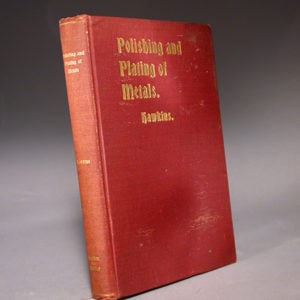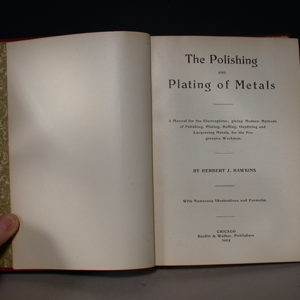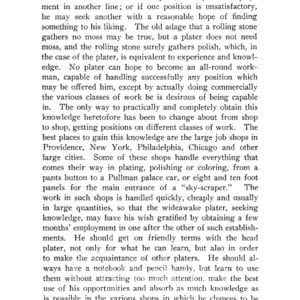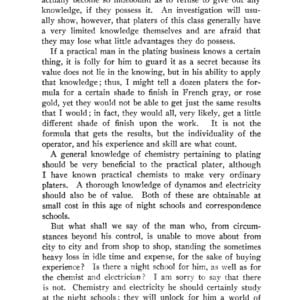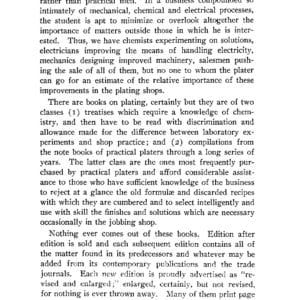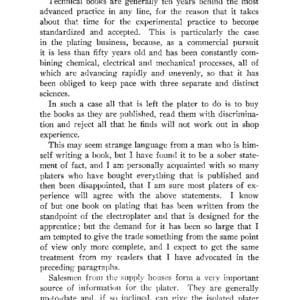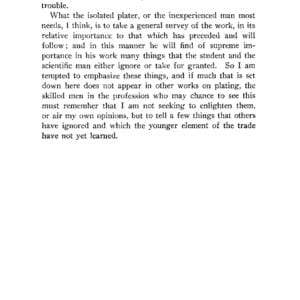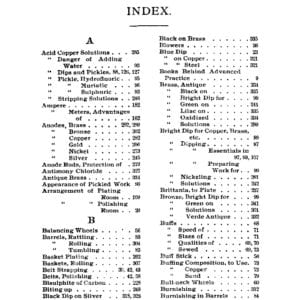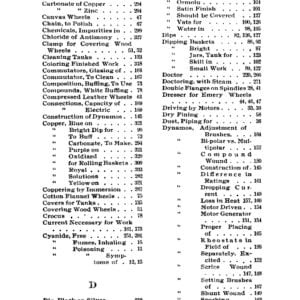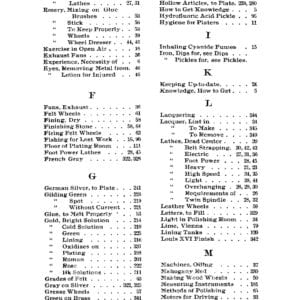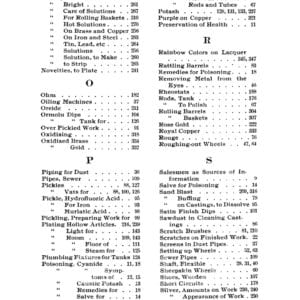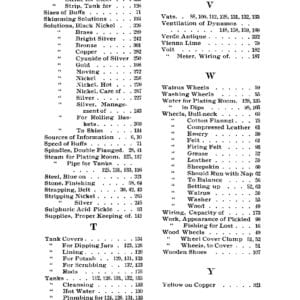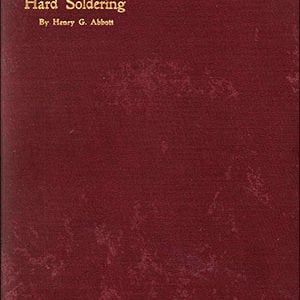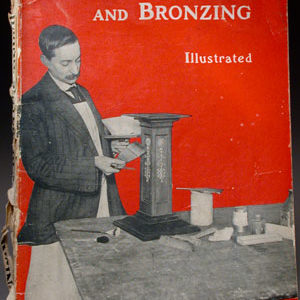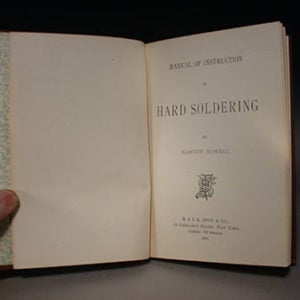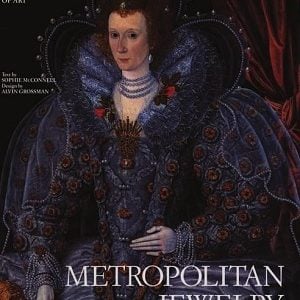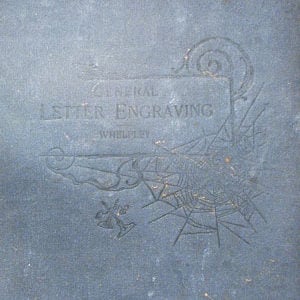The Polishing and Plating of Metals by Herbert J. Hawkins, 1902
A Manual for the Electroplater, giving Modern Methods of Polishing, Plating, Buffing, Oxidizing and Lacquering Metals, for the Progressive Workman.
This 1902 book is a huge volume, 358 pages of solid information (this edition was published 1904). The author begins with a discussion of specialization in the plating world, and how this leads to problems if people change jobs. How much better if a person understood and could practice the whole spectrum of plating. The only way at that time to get a full understanding was to work in different shops, even staying just a few months before moving on. This book is an attempt to supply the eager workman with a compendium of the field, a full education in a single place.
There are many illustrations, photographs and diagrams in this book. Note that the sections at the end, on silver and gold plating, on metal coloring and patination are excellent.
This review is longer than usual as a result of the amount of information in the book.
The author criticizes existing books on plating as being either chemistry texts informed by laboratory experiments and not practically applicable or compilations of practical experiences which while useful to a very knowledgeable person who can discriminate and discard useless or dangerous recipes are nevertheless full of mistakes (compounded by accumulation and repetition through time) and bad practice. This book seeks to address this. He notes that current practice accepting new ideas takes about ten years.
The book begins with a discussion of health and safety, or rather of what being a plater meant then. For instance, with little glove use he discusses the variance in how people’s hands are attacked by the cyanide solutions. Nasty stuff, and a real reminder of what you deal with in plating, and how far we have come in understanding, and safety equipment. The health problems are described in gruesome detail. It is clear that dermatitis, boils and other symptoms were considered an everyday occurrence and simply part of the job. For instance platers are recommended to take a steam bath once a week, and to notice that there is a distinct smell of cyanide in the sweat, thus proving that upon exposure it enters the body. And so on, with a very cowboy approach to chemical exposure. The descriptions of the woes and results should have scared off most reasonable people. Wow. There are recipes for skin creams including ‘skin food’ to heal the skin.
Next is a great chapter on polishing, its importance in metal preparation and shop layout issues. All sensible and smart. Incredible engravings of machines and equipment are there to accompany the text. There are many many illustrations and engravings in the book. There is a really wild early flexible shaft for grinding castings that looks like a recipe for entanglement adventures. Emery wheels were made in different ways by combining emery with cements and these could explode, the author saw a chunk of every wheel go through a twenty inch thick brick wall. In fact these are a kind of grinding wheel, but in finer grits than normal, and used for sanding operations as well as more coarse removal. There is a good description of using a grinding wheel dresser to smooth a wheel.
There is a scary story of how to remove splinters of metal embedded in an eyeball using a horsehair bent into a loop which is dragged over the surface of the eye until it catches on the splinter allowing it to be suddenly yanked out. I actually have a similar tool made from thin fishing line that I got in Germany from a die sinker. Really makes you want to wear safety glasses.
A section on making your own buffs makes the point that the canvas discs used should alternate directions of weave to make the buff last longer and work well. Making wooden wheels is covered, with leather coverings. The number of details of buffing and polishing are enormous and intense and lets you realize how much simpler life in the workshop is today for a jeweler. There is an extensive description of different polishing compounds, how they are made and used. Tumbling is addressed, and one interesting tidbit is that the shape of toy jacks were originally ‘jackstones’ and were a tumbling shot shape for getting into hollows when tumbling steel castings. Oddities include tumbling barrels with holes in them running in a bath of soapy water, all metal and dust removed ends up outside the barrel in the easily changed pan of soapy water, and using small scraps of dry leather as the tumbling media to get a bright finish on small parts, or that tumbling barrels that are bigger in the middle than the ends are much faster at finishing than straight sided ones.
A chapter on acids and pickling solutions follows. The absence of plastics is noticeable, as in pickle barrels made of wood coated with asphaltum, in fired ceramic stoneware baskets for hanging work and more. The author concentrates on iron castings and cleaning them before going on to describe other metals. The information is very thorough, but predates the use of salts that dissociate to form low dilutions of acids for pickle solutions. Many of the recipes would be seen as dangerously strong today.
Satin finishes and dips for producing those surfaces are described. Ormolu dips as well, which produce golden yellow finishes on brass, to be lacquered or plated. Wooden shoes with two inch thicknesses are recommended as the floors of plating shops were often wet with water and mixed chemicals. Nasty working conditions.
The layout of shops is dealt with, the plumbing and flooring types and considerations. Basements are recommended for plating shops. Cement tanks are suggested, and their building is exhaustively described. Rammed concrete was used at this time. Lining of tanks is fully described. Steam was used to heat solutions and so steam generation and handling is addressed.
Dynamos and electricity generation, machine building, wiring, and more is dealt with. Some of the large generators pictured look quite frightening. All the connections, meters, controls, bus bars etc are pictured and described.
There is a burning call for scientists and platers to research and compile tables of current densities and metals, which all now exist, but at the time were lacking. This book however does give some detail for this.
The chapters on gold plating and gilding are especially interested and thorough. The recipes for gold and gold alloy (and colors such as red or green) solutions are really interesting. They are fully detailed for making solutions from scratch. Solutions and methods for gold plating without electricity are described.
Silver plating is equally well addressed, in great detail. Lots of recipes are given. Further extensive chapters deal with nickel plating, copper plating of all kinds, brass plating and all its subtleties, bronze plating (I have not seen this addressed elsewhere).
The chapter on burnishing is very intriguing with many illustrations of shapes and types of burnishers.
A great, very large chapter on metal coloring and patination has many recipes in detail. A unique one is to use a very old liver of sulfur solution with a lot of ammonia which give a greenish tone on silver. There are dozens of recipes, all kinds of reds, greens and other colors on metals. A number of painted on colorings are described.
A final chapter on lacquering is a fitting finish for the book. Very well described and detailed.
So, if interested in plating, metal coloring and patinas this book is a must-have.
Lewton-Brain 2013
File Size: 41.5MB, 358 Pages
